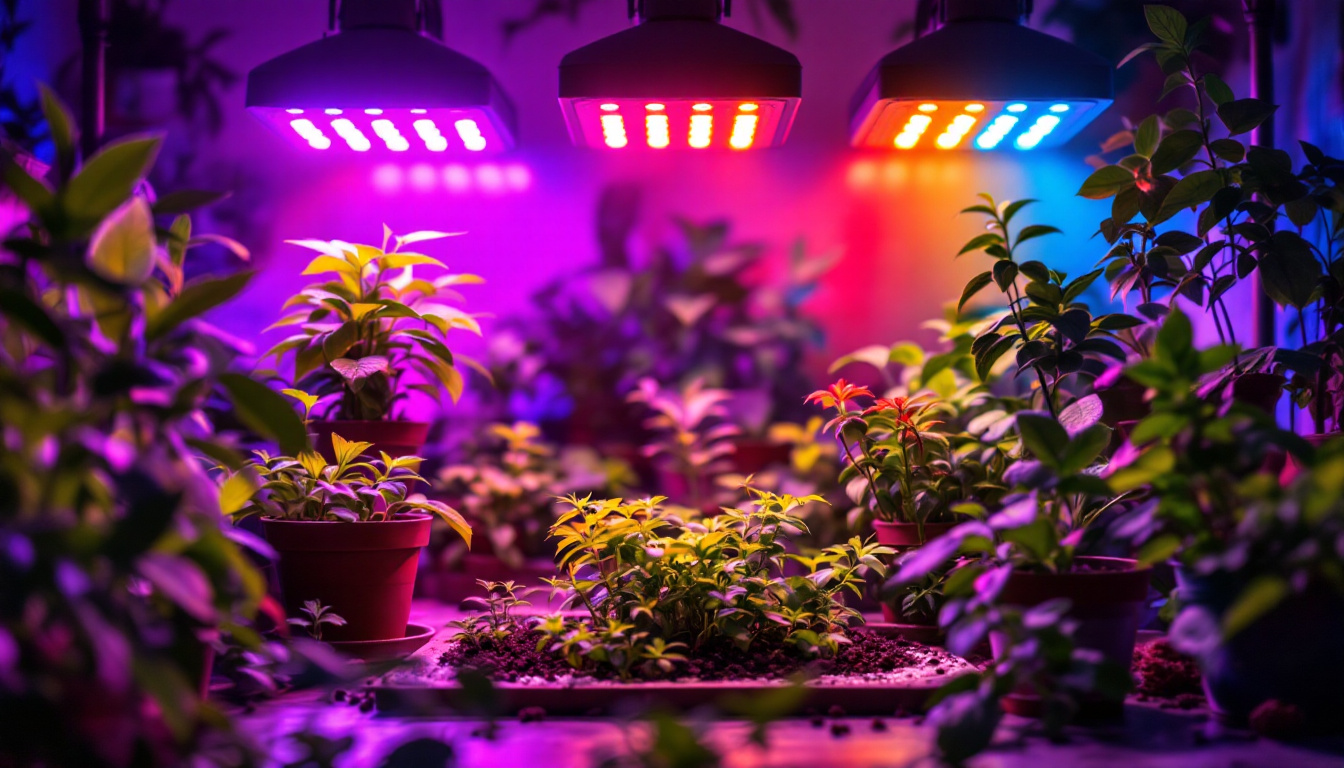
In the ever-evolving world of horticulture and indoor gardening, the importance of proper lighting cannot be overstated. Grow light LEDs have emerged as a revolutionary solution, providing energy-efficient and effective lighting for plants. Unlike traditional lighting options, LED grow lights emit specific wavelengths of light that are most beneficial for photosynthesis, allowing plants to thrive even in the absence of natural sunlight. Lighting contractors play a crucial role in helping growers select the right systems to optimize plant growth. Understanding the nuances of grow light LEDs is essential for contractors looking to excel in this niche market.
This article aims to equip lighting contractors with the top resources and insights needed to master grow light LEDs. From understanding the technology behind these lights to exploring installation techniques and maintenance tips, this comprehensive guide will serve as a valuable reference. Additionally, it’s important to consider the varying needs of different plant species, as some may require specific light spectrums or intensities to flourish. For instance, flowering plants often benefit from a different light spectrum compared to leafy greens, making it imperative for contractors to have a thorough understanding of these requirements when advising clients.
Furthermore, the advancements in LED technology have led to the development of smart grow lights that can be controlled via mobile applications, allowing growers to customize their lighting schedules and intensities with ease. This not only enhances plant growth but also contributes to energy savings, as growers can adjust their lighting based on the specific needs of their plants throughout different growth stages. As the demand for indoor gardening continues to rise, staying informed about these innovations will empower lighting contractors to provide cutting-edge solutions that meet the evolving needs of their clients.
Before diving into the specifics of installation and application, it is vital for lighting contractors to grasp the fundamental technology behind grow light LEDs. This knowledge not only enhances their credibility but also ensures they can provide informed recommendations to clients. As the demand for indoor gardening and commercial horticulture continues to rise, understanding the nuances of grow light technology becomes increasingly important for professionals in the field.
Light Emitting Diodes (LEDs) operate on a principle of electroluminescence, where electrons recombine with holes within the device, releasing energy in the form of photons. This process is highly efficient compared to traditional lighting methods, resulting in lower energy consumption and heat output. For contractors, understanding this mechanism is crucial when discussing energy savings with clients. Additionally, the lifespan of LEDs is significantly longer than that of conventional bulbs, often exceeding 50,000 hours, which means less frequent replacements and reduced waste over time.
Grow light LEDs offer numerous advantages over traditional lighting options such as fluorescent or incandescent bulbs. Firstly, they consume significantly less energy, which translates to lower electricity bills for growers. Secondly, LEDs produce less heat, reducing the risk of plant damage and the need for additional cooling systems. This aspect is particularly beneficial in tightly controlled environments where temperature regulation is critical for optimal plant growth.
Moreover, LEDs can be tailored to emit specific wavelengths of light that are most beneficial for plant growth. This customization allows for enhanced photosynthesis, leading to healthier plants and potentially higher yields. For instance, blue light promotes vegetative growth, while red light is essential for flowering and fruiting stages. Contractors should emphasize these benefits when consulting with clients, as they can greatly influence purchasing decisions. Furthermore, many modern LED systems come equipped with smart technology, allowing growers to adjust light intensity and spectrum remotely, thereby optimizing growth conditions based on real-time data and specific plant needs. This integration of technology not only enhances the growing experience but also provides an edge in competitive markets where efficiency and productivity are paramount.
With a myriad of grow light LED systems available in the market, selecting the right one can be daunting. Lighting contractors must consider various factors to ensure they recommend the most suitable options for their clients’ specific needs.
There are several types of grow light LEDs, each designed for different applications. Full-spectrum LEDs are popular for general use, as they provide a balanced spectrum that mimics natural sunlight. These lights are ideal for all growth stages, from seedling to flowering.
On the other hand, specialized LEDs focus on specific wavelengths to enhance certain growth phases. For instance, blue light is crucial during the vegetative stage, while red light promotes flowering and fruiting. Understanding these distinctions allows contractors to tailor their recommendations based on the plants being cultivated.
Another critical consideration is the light intensity and coverage area required for effective plant growth. Different plants have varying light requirements, and it is essential to match the LED output to these needs. Contractors should utilize tools such as light meters to measure intensity and ensure adequate coverage across the growing area.
Additionally, the height at which the lights are installed can significantly impact light distribution. Contractors should educate clients on the importance of adjusting the height of grow lights as plants grow to maintain optimal light exposure.
Proper installation of grow light LEDs is pivotal for maximizing their effectiveness. Lighting contractors must adhere to best practices to ensure a seamless setup that meets both safety and performance standards.
When installing grow light LEDs, it is essential to consider the electrical requirements of the system. Contractors should ensure that the electrical circuits can handle the load, taking into account the total wattage of the lights being installed. This may involve consulting with an electrician to verify that the existing wiring is adequate.
Moreover, utilizing timers and dimmers can enhance the functionality of grow light systems. Timers allow for automated light cycles, mimicking natural daylight patterns, while dimmers enable contractors to adjust light intensity based on the growth stage of the plants.
Proper mounting and positioning of grow lights are crucial for achieving even light distribution. Contractors should consider using adjustable mounting systems that allow for easy height adjustments as plants grow. This flexibility ensures that light intensity remains consistent throughout the growing cycle.
Additionally, positioning the lights at the correct angle can help maximize light penetration into the plant canopy. Contractors should educate clients on the importance of regularly checking and adjusting the positioning of lights to maintain optimal growth conditions.
Once grow light LEDs are installed, ongoing maintenance is essential to ensure their longevity and effectiveness. Lighting contractors should provide clients with guidance on routine maintenance practices and troubleshooting common issues.
Dust and debris can accumulate on the surface of grow lights, reducing their efficiency. Contractors should recommend a regular cleaning schedule to clients, emphasizing the importance of using non-abrasive materials to avoid damaging the lights. Additionally, regular inspections can help identify any potential issues before they escalate.
Despite their reliability, grow light LEDs can encounter issues over time. Contractors should be prepared to troubleshoot common problems such as flickering lights, uneven light distribution, or complete failure to turn on. Understanding the potential causes of these issues, such as faulty wiring or driver malfunctions, allows contractors to provide effective solutions.
As technology continues to advance, integrating smart systems into grow light setups has become increasingly popular. Lighting contractors should stay informed about the latest innovations in smart technology to offer clients enhanced functionality and control over their grow light systems.
Smart controllers allow growers to automate their lighting schedules, adjusting light intensity and duration based on specific plant needs. These systems can be programmed to mimic natural light cycles, promoting healthier plant growth. Contractors should be familiar with various smart controller options and their compatibility with different grow light systems.
Additionally, integrating sensors that monitor environmental conditions, such as temperature and humidity, can further optimize plant growth. Contractors can recommend systems that adjust lighting based on real-time data, ensuring that plants receive the ideal conditions for growth.
Remote monitoring capabilities enable growers to manage their lighting systems from anywhere, providing convenience and peace of mind. Contractors should explore options that allow clients to control their grow lights via smartphones or tablets, offering greater flexibility and control over their indoor gardening operations.
Learning from real-world examples can provide valuable insights into the effective use of grow light LEDs. Lighting contractors can benefit from studying successful implementations to understand best practices and innovative approaches.
Many commercial greenhouses have successfully integrated grow light LEDs to enhance production efficiency. By utilizing full-spectrum LEDs, these facilities have achieved consistent yields throughout the year, regardless of external weather conditions. Contractors can draw inspiration from these case studies to demonstrate the potential benefits of LED lighting to their clients.
Urban indoor farms have also embraced grow light technology to maximize space and resources. By strategically layering plants and utilizing vertical farming techniques, these operations have leveraged LED lighting to create sustainable food sources in urban environments. Contractors can highlight these examples to showcase the versatility of grow light LEDs in various settings.
Mastering grow light LEDs is essential for lighting contractors aiming to excel in the horticultural sector. By understanding the technology, selecting the right systems, and implementing best practices, contractors can provide invaluable support to their clients. Additionally, staying informed about advancements in smart technology and learning from successful case studies will further enhance their expertise.
As the demand for efficient and effective indoor gardening solutions continues to grow, lighting contractors who invest time in mastering grow light LEDs will position themselves as trusted advisors in the field. With the right resources and knowledge, they can help clients achieve optimal plant growth and productivity, ultimately contributing to a greener and more sustainable future.
Ready to elevate your lighting game and become a go-to expert in grow light LEDs? LumenWholesale is here to support you every step of the way. Our extensive selection of top-quality, spec-grade lighting products comes at unbeatable wholesale prices, ensuring you can provide your clients with reliable and high-performance lighting solutions. Say goodbye to local distributor markups and hello to superior products with free shipping on bulk orders. Don’t compromise on quality or value; choose LumenWholesale for the perfect blend of affordability and convenience. Take the first step towards a greener future and explore our wholesale lighting options at the best value today.

Discover effective strategies to educate your team on pendant light fixture parts, enhancing their expertise in lighting solutions.

Discover how arena lighting can be your competitive edge in securing more contracts.

Discover the must-know essentials for lighting contractors when it comes to outdoor deck lamps.
Discover essential tips and insights for lighting contractors working with LED bulb mogul bases.